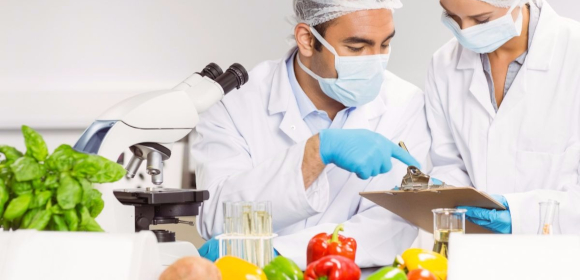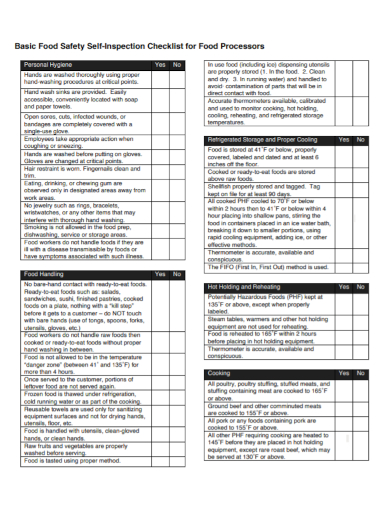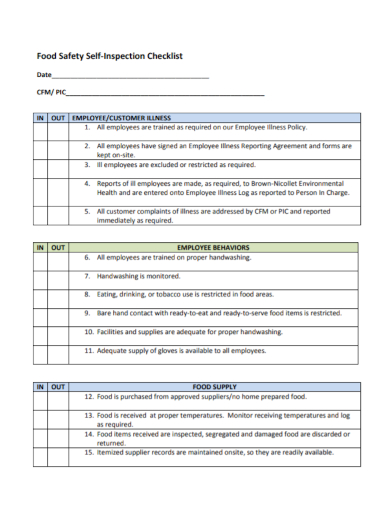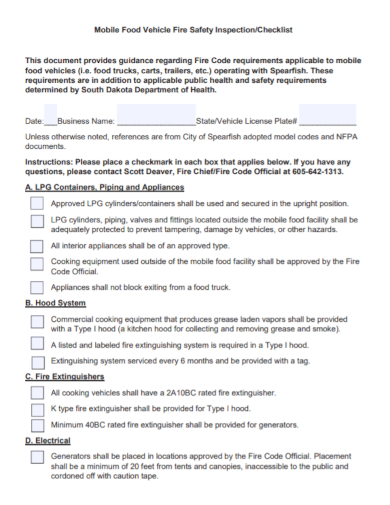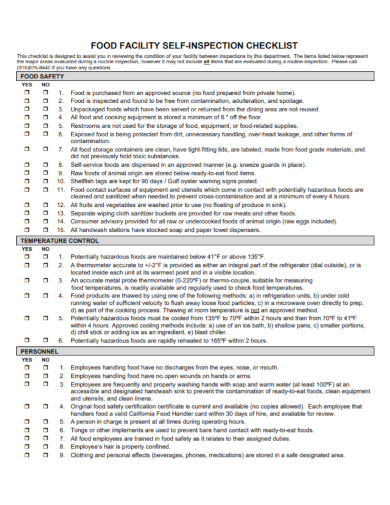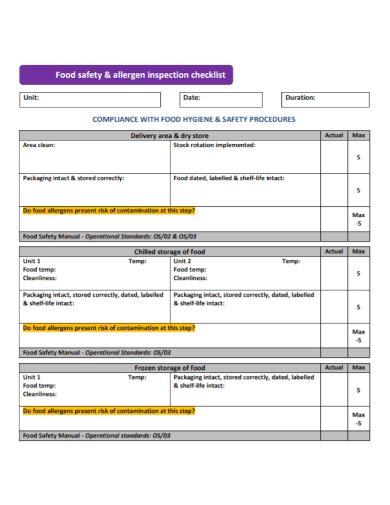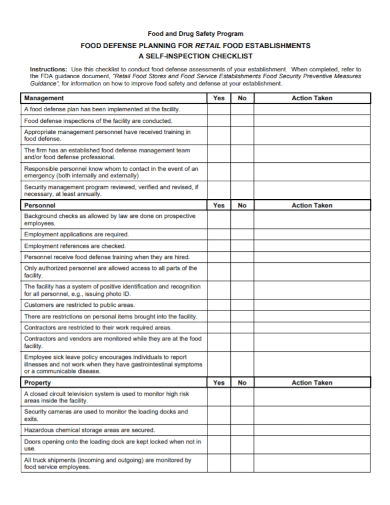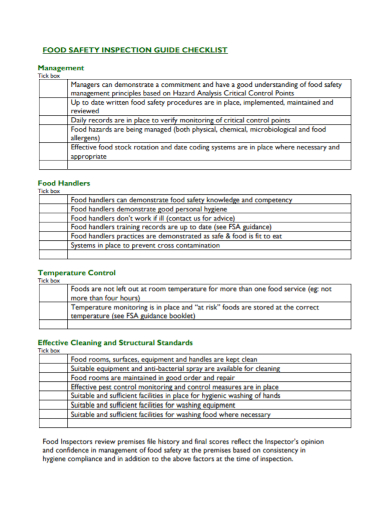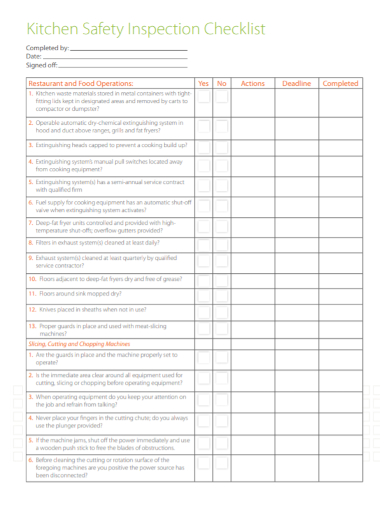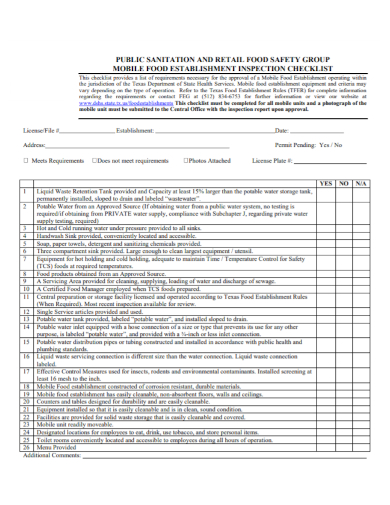The World Health Organization (WHO) reported that an estimated 600 million people get illnesses after consuming contaminated food and water each year, resulting in 420,000 deaths from around the world. Even with this data and policies and regulations implemented by authorities to the food business, food safety is still taken for granted since diseases from contaminated food and food poisoning are still rampant and remaining as a global health issue. That is why food inspectors are assigned to inspect food business establishments to conduct inspections to see if the business adheres to food safety standards. Read the article to find out how to make a food safety inspection checklist.
10+ Food Safety Inspection Checklist Samples
1. Food Safety Self-Inspection Checklist
2. Food Safety Inspection Checklist
3. Food Vehicle Safety Inspection Checklist
4. Food Facility Safety Inspection Checklist
5. Food Hygiene Safety Inspection Checklist
6. Food Safety Establishment Inspection Checklist
7. Food Safety Management Inspection Checklist
8. Food Health and Safety Inspection Checklist
9. Kitchen Food Safety Inspection Checklist
10. Food Safety Group Inspection Checklist
11. Food Safety Control Plan Inspection Checklist
The Importance of Using a Food Safety Checklist
Food safety is synonymous with handling, preparing, and storing food properly to reduce the risk of anyone getting sick from foodborne illnesses. A food safety checklist is a tool that food inspectors must have and use because it promotes food safety and sets quality standards for employees to ensure they complied with it. It also helps identify food safety threats and risks and set actions to alleviate them. Food safety inspections must be done regularly to promote and follow the safety culture. If no one condones to food safety, the food is highly likely to get contaminated with different bacteria and viruses that could cause diseases to anyone who comes in contact with it. The risks associated with poor food safety are caused by improper food handling, poor personal hygiene of food handlers, and unsanitized kitchen tools, equipment, and facilities.
How to Create a Food Inspection Checklist
- Employee illness: Make a list that that determines if an employee is sick. If they are sick with transmittable diseases, they should be excused from any tasks relating to handling food. A food company or a restaurant has a policy regarding employee sickness and the staff must make sure to adhere to it. Check also if the employees are wearing the proper attire when handling food.
- Employee behavior: The list here must determine how employees should behave on handling food and should strictly follow your protocol such as the kitchen must have a handwashing area, employees must wash their hands at all times, and employees are not allowed to touch ready to serve food, and smoke inside the kitchen. You can also add to the list here on how you inspect the employee’s personal hygiene too.
- Food supply: Determine the ways in how the food supply is delivered and handled. For example, check to see if the food came from approved suppliers if the food is separated from each category to protect from cross-contamination (raw and cooked food are stored separately) and if the food supply is stored at the right temperature.
- Food protection: The list must take down how the food must be handled and protected properly. Check to see if all surfaces that come in contact with the food are sanitized properly if all the hot and cold holding temperatures are maintained if the cooked food is at its right temperature (to see if it isn’t undercooked or overcooked) if the thermometer is checked regularly to see if they are accurate in their temperature readings, and overseeing the foods that are about to expire.
- Chemical storage: This list here must determine whether the harmful chemicals are being stored properly and away from food. Check also to see if the staff knows how to handle harmful chemicals properly.
- Physical facilities: Check to see if the whole facility, such as the kitchen and the whole dining area from top to bottom is clean and free from dust and dirt. Check to see if the potable water supply is clean and safe to drink, if the whole facility is free from pests and animals, if there is proper waste disposal, and the employees must not let unauthorized persons go inside the kitchen.
To help with your inspection review, document your inspection by taking photos of all the compliant and non-compliant items. This will help capture evidence especially on food safety threats; make sure to label your photos accordingly and attach them to your checklist for a comprehensive report.
If you see that the employees are non-compliant on the day of the inspection process, assign corrective actions to the issues you identified. Make sure the employees will comply with your corrective actions by setting a due date to correct it and assuring them you will conduct a reinspection.
FAQs
What are 5 common food safety violations?
The most common food violations identified by the FDA are usually occurring frequently. These violations are poor pest control, complacent with contamination on food handling, lack of handwashing practice, poor sanitization, and improper temperature.
What are the 4 C’s of good food hygiene?
The 4Cs of good food hygiene is cleaning, cooking, cross-contamination, and chilling. To summarize these, it’s important to make sure that your area and hands are clean when handling and storing foods, keeping your foods chilled, cooking them at the right temperature, and keeping different types of food from each other.
What is the right temperature for food?
According to the Minnesota Department of Health, there are three important temperatures to remember when cooking meat or eggs; Eggs and ground meats must be cooked to 160°F; poultry must be cooked to 165°F, and fresh meat steaks and roasts must be cooked to 145°F.
Food inspectors must schedule food safety inspections regularly so food establishments will not grow complacent in food safety. When food handlers value food safety, food poisoning and food diseases will less likely to occur. Everyone deserves to eat food that is healthy and safe to consume. To guide you on creating a food safety inspection checklist, download our sample templates provided above. They are free and easy to download so you can download as many templates as you like!
Related Posts
FREE 20+ Employee Checklist Samples
FREE 19+ Delivery Checklist Samples
FREE 18+ Restaurant Checklist Samples
FREE 16+ Sample Daily Checklists
FREE 13+ Equipment Checklists
FREE 10+ Sample Risk Assessment Checklist
FREE 9+ Sample Home Inspection Forms
FREE 5+ Retail Audit Checklist Samples
Checklists to Boost Efficiency and Reduce Mistakes
How to Create a Checklist?
FREE 43+ Sample Checklist
FREE 25+ Sample Restaurant Checklist
FREE 18+ Wedding Registry Checklists
FREE 13+ Induction Checklist Samples
FREE 10+ Retail Cleaning Checklist Samples
